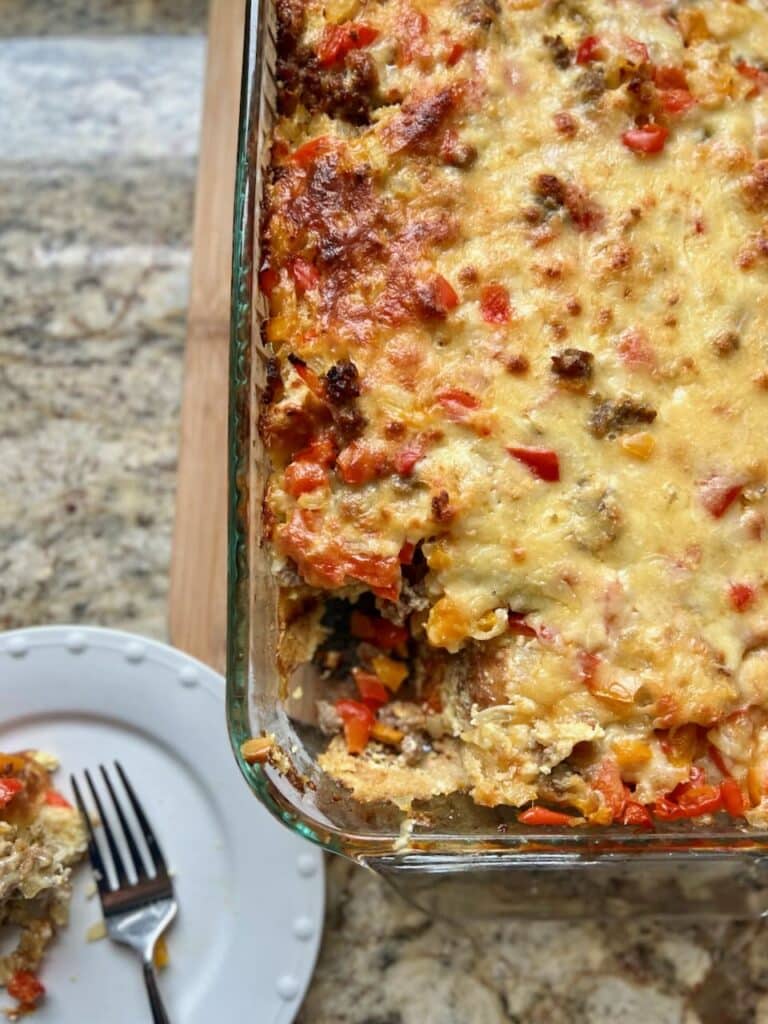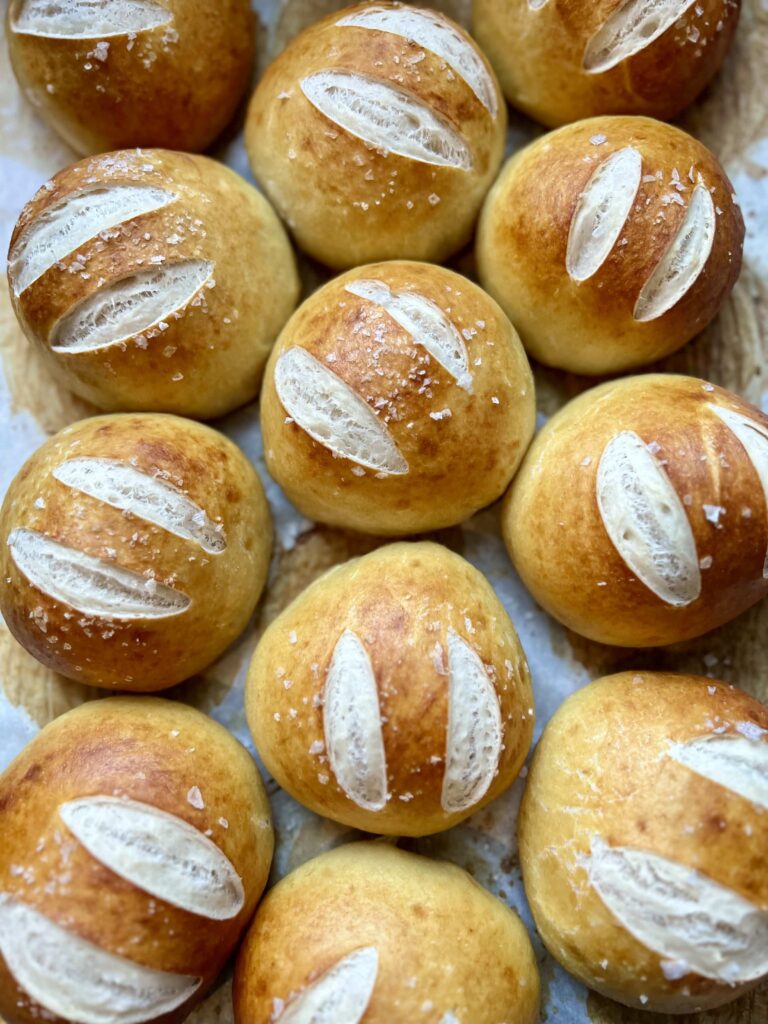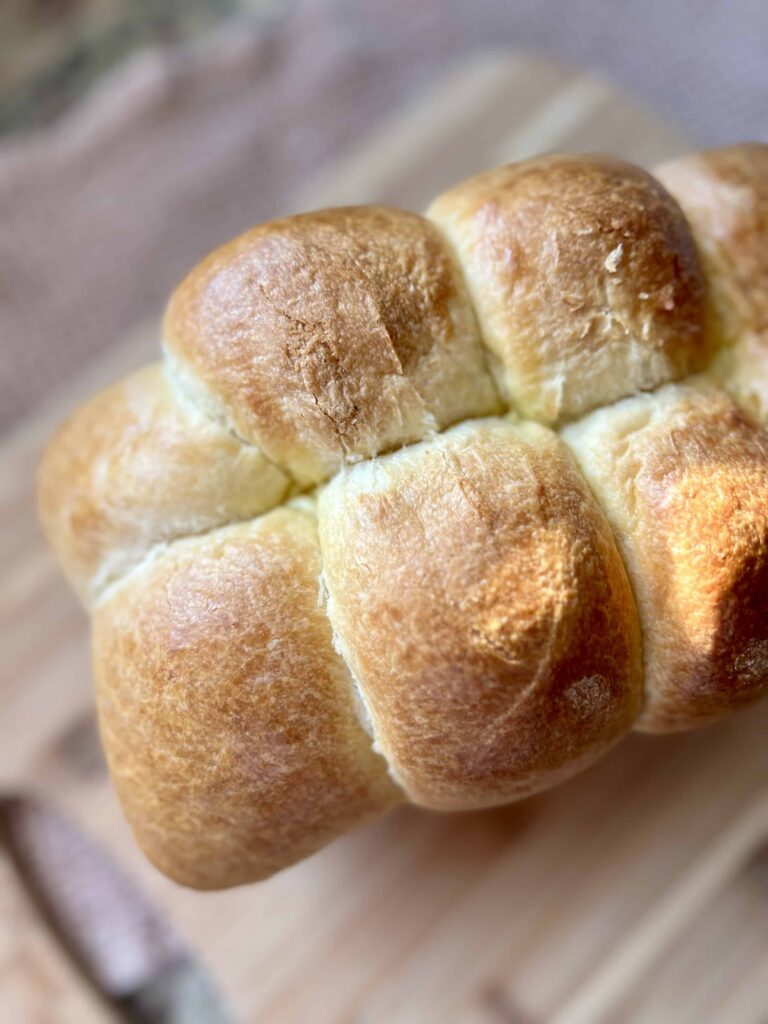Pumpkin Sourdough Artisan Bread
This post may contain affiliate links. Please read our disclosure policy.Welcome fall with this delicious pumpkin sourdough artisan bread. This artisan bread is made with canned pumpkin mixed right into the dough, giving the crumb a beautiful texture and a crispy artisan crust. Lightly sweet, this bread is perfect for breakfast, a quick snack or to enjoy with some butter. It’s a favorite bread for this time of year. Try it today and let me know how you like it!

Ingredients in Pumpkin Sourdough Artisan Bread
Sourdough Starter: Use an active/ripe sourdough starter (doubled in size/bubbly/mild sour aroma) to mix the levain.
Canned Pumpkin: Canned pumpkin gives this pumpkin bread its name! It also provides a soft and tender crumb. Do not use pumpkin pie filling. The only ingredient in the canned pumpkin is pumpkin. I have not tried this with homemade pumpkin. Homemade pumpkin tends to be more watery, so I would decrease the water a little in the recipe if you use homemade pumpkin puree.
Brown Sugar: I sweeten this bread with some brown sugar. The taste of the brown sugar complements the pumpkin and pumpkin pie spice. If you prefer a savory bread, leave the sugar out and increase the water to 230 grams total.
Bread Flour: I almost always use a 12.5% protein bread flour for any bread that I am kneading. The higher protein content and properly activating the gluten results in a lighter/springy baked good.
Salt: Salt enhances the flavor, don’t leave it out!
Pumpkin Pie Spice: I laminate pumpkin pie spice into the dough for a beautiful swirled effect. It enhances the flavor and makes the finished loaf stand out. You can leave it out if desired.

Sourdough Sample Schedule for Pumpkin Sourdough Artisan Bread
A sample baking schedule helps me when baking with sourdough. Sourdough takes much longer to rise than traditional bread. This schedule helps me plan my bake.
Note: This schedule assumes the dough temperature is 78 degrees F throughout the process.
| Day 1 | Levain/Mixing/Bulk Fermentation/Shaping/Cold Bulk Fermentation |
| 8:00 AM –11:30 AM | Mix Levain. Let sit at 78 degrees F for about 3-4 hours until doubled/bubbly and ripe. |
| 11:30 AM | Fermentolyse: Mix bread flour, water and ripe/active/bubbly levain. Let sit for 30 minutes before adding in the rest of the ingredients. |
| 12:00 PM | Mix Dough: Add pumpkin, salt and brown sugar (if desired) |
| 12:30 PM 1:00 PM 1:30 PM | Stretch and Fold #1 Stretch and Fold #2 Stretch and Fold #3 |
| 3:30 PM | Laminate in Pumpkin Pie Spice Bench Rest |
| 4:00 PM | Shape Dough Begin Cold Bulk Fermentation |
| Day 2 | Bake |
| 9:00 AM | Bake and Enjoy! |


Mixing the Levain
1:1:1 Levain (ready in 3-4 hours/same day): This recipe calls for a levain mixed the same day you mix the dough. It should take 3-4 hours until it’s ready to be mixed with the dough, if you keep the levain temperature at 78 degrees F. Levain is ready when it has doubled in size, has lots of bubbles, a slightly sour aroma and is just about to start going down from its peak height. Mix together:
- 30 grams of ripe/mature starter
- 30 grams of warm water
- 30 grams of bread flour
If you prefer to mix the levain the night before, you can mix a 1:10:10 Levain that is ready in 12 hours or overnight
- 4 grams of ripe/mature sourdough starter
- 40 grams white bread flour
- 40 grams water

Fermentolyse the Dough
I use a fermentolyse method in this pumpkin sourdough artisan bread. It helps strengthen the gluten strands in the dough and gives a better overall texture and crumb to this bread. As soon as the levain is ready (bubbly, doubled in size, peaked), mix together the bread flour, water and levain. Cover the dough and let it rest for 30 minutes.

Mixing the Dough
Add the canned pumpkin, salt and brown sugar to the fermentolysed dough. Pinch chunks of dough and reincorporate them together gently. Pick up one side of the dough and fold it over on itself. The dough will be sticky. Wet your hands as needed and continue to work with the dough, gently kneading until all the ingredients are incorporated and the dough is smooth. This will probably take 3-5 minutes. Transfer the dough to a plastic container or a glass bowl if desired.
A Savory Option: If you prefer a savory loaf, leave out the brown sugar and increase the water to 230 grams total.



Bulk Fermentation
The total bulk fermentation time is around 4-5 hours, from the time the levain hits the dough to when the dough is shaped (and then refrigerated). This timing assumes a dough temperature of around 78 degrees F. During this bulk fermentation, I perform three sets of stretch and folds to help strengthen the dough. If after the third stretch and fold, the dough doesn’t feel elastic and isn’t cohesive, add another set or two of stretch and folds.
Stretch and Fold: To “stretch and fold,” wet your hand (so it doesn’t stick to the dough). Reach down to the bottom of the bowl of dough and pull the dough up and over the top of the dough. Turn the bowl 1/4 turn and repeat the stretch and fold. Turn another 1/4 turn and repeat. Perform one more 1/4 turn with stretching and folding the dough. Cover and set aside.



Laminate In the Pumpkin Pie Spice
Once the dough has risen about 20-30%, has a few bubbles scattered around the top and feels extensible and aerated, it’s time to pre-shape the dough and laminate in the pumpkin pie spice. The lamination method adds layers of pumpkin pie spice into the dough. These layers look beautiful when you cut into the dough, and they enhance the flavor of this pumpkin loaf.
Lamination: On a clean counter top, stretch the dough as thin as you can without tearing it. When the dough is fully stretched, sprinkle pumpkin pie spice over the dough. Fold the dough up and sprinkle a little more pumpkin pie spice as you fold the dough up into a little package. This strengthens gluten strands and gives even dispersement of spices. Let the dough rest about 30 minutes before shaping.











Shaping Pumpkin Sourdough Artisan Bread
Prepare a banneton or small bowl. Place a kitchen towel or hair net in the bowl and liberally flour. If you use the hair net, you may not need to use much flour. Pre-shape the risen dough by dragging it into a circle on the countertop and letting it rest for about 30 minutes uncovered. Then it’s time to shape!








Cold Fermentation
I almost always use a cold fermentation for my sourdough artisan bread. Cover the dough in the banneton and place in the refrigerator for 12-20 hours. If it goes a little longer than that, it should be okay maybe up to 48 hours depending on the temperature of your refrigerator.


Baking Pumpkin Sourdough Artisan Bread
Pre-heat the Oven: Put a dutch oven (top and all) into the oven and preheat to 500 degrees. Allow the dutch oven to heat for about 30 minutes at 500 degrees. This builds up steam, which is necessary to achieve the beautiful oven spring and perfect crust that artisan bread is known for.
Scoring the Dough: Once the oven is preheated for 30 minutes, pull the loaf out of the refrigerator. Remove the plastic wrap (this is easy to do straight out of the refrigerator if the dough is chilled – not easy if the dough warms up) and place a piece of parchment paper on top of the bread dough. Flip the dough over so that it is now sitting on the parchment paper. Take off the bowl/banneton and kitchen towel. Smooth the flour over the top of the dough (add a little extra for more contrast if desired) or leave the flour off completely for no contrast. Use a bread lame or very sharp knife to score the dough.


Baking the Bread: Carefully remove the dutch oven from the 500 degree oven with hot pads. Take the top off and place your bread into the dutch oven (including parchment paper – this helps with the transfer). Be very careful not to touch the sides of the hot dutch oven. Put your hot pads back on before you pick up the lid of the dutch oven and place it on top of the bread. Put the whole dutch oven back into your oven. Lower the temperature to 450 degrees and bake for 20 minutes. Once 20 minutes are up, take the top off the dutch oven and continue baking for 20 minutes until the bread is fully baked.



Want bread shaped like a pumpkin? Find out how to do it here.


Frequently Asked Questions
I let my loaves cool completely. Then slice them and freeze in an airtight container or ziplock bag for up to 3 months. Bring to room temperature to enjoy or toast from frozen.
It is best not to add the spices directly in the dough. Cinnamon in particular can hinder fermentation. It is best to laminate the pumpkin pie spice (or cinnamon) in at the end of bulk fermentaiton.
You can, but you will need to decrease the water in the recipe. Homemade pumpkin puree tends to be more watery than canned pumpkin. Account for that by using less water in the dough.
Yes. This recipe makes a smaller loaf of sourdough artisan bread, about 2/3 the size of a traditional sourdough loaf, so if you’d like to increase the ingredients to make multiple loaves or increase the size of this loaf, that works well.







Pumpkin Sourdough Artisan Bread
Ingredients
Levain (1:1:1, 3-4 hours)
- 30 grams ripe sourdough starter bubbly/active/doubled in size
- 30 grams all purpose or bread flour
- 30 grams water
Pumpkin Sourdough Artisan Bread
- 75 grams levain ripe/bubbly/active/doubled in size
- 200 grams water
- 350 grams bread flour 12.5%
- 100 grams canned pumpkin see recipe notes
- 50 grams brown sugar see recipe notes
- 10 grams salt
- 2 grams pumpkin pie spice can substitute cinnamon
Instructions
Day 1: Levain/Mix/Bulk Fermentation/Shape/Cold Bulk Fermentation
- Levain: Make levain by mixing together ripe sourdough starter, flour and water. Set aside for 3-4 hours at 78 degrees F.
- Fermentolyse: Once the levain is ripe/bubbly/doubled in size, mix together the ripe levain, bread flour and water. Let rest for 30 minutes.
- Mixing: Add canned pumpkin, brown sugar and salt to the top of the fermentolysed dough. Pinch chunks of dough and reincorporate them together gently. Pick up one side of the dough and fold it over on itself. The dough will be sticky. Wet your hands as needed and continue to work with the dough until it is smooth and all the ingredients are mixed and the dough is smooth, about 3-5 minutes. Transfer the dough to a plastic container or a glass bowl if desired.
- Bulk Fermentation: Over a total of 3.5-4 hours, perform 3 sets of stretch and folds every half hour.
- To “stretch and fold,” wet your hand (so it doesn’t stick to the dough). Reach down to the bottom of the bowl of dough and pull the dough up and over the top of the dough. Turn the bowl 1/4 turn and repeat the stretch and fold. Turn another 1/4 turn and repeat. Perform one more 1/4 turn with stretching and folding the dough. Cover and set aside.
- Repeat the stretch and folds every 30 minutes for three times total. After your third set of stretch and folds, cover the dough and let rest/rise for about 1.5-2 hours.
- Lamination & Bench Rest: On a clean counter top, stretch the dough as thin as you can without tearing it. See post for pictures and description. When the dough is fully stretched, sprinkle pumpkin pie spice over the dough. Fold the dough up and sprinkle pumpkin pie spice as you fold the dough up into a little package. See post for pictures. Let the dough rest for about 30 minutes.
- Shaping: After the dough has rested for about 30 minutes, it is time to shape the bread into a round or oval shape. Sprinkle flour on top of the dough if desired (I use a fine mesh strainer). Using the bench knife, lift the dough up off the counter and place it on top of the countertop – floured side down. This ensures that the flour is staying mainly on the outside of the dough. Pull the dough down toward you and then fold up to the middle of the dough. Take the right edge and pull out and then into the middle of the dough. Take the left side of the dough and stretch out and then back to the middle. Repeat with the top of the dough, forming a little "package" of dough. Gather the bread into a circle and use a bench knife to lift the bread and place into your lined bowl.
- Cold Bulk Fermentation: Cover the dough and store in the refrigerator overnight or for up to 18-20 hours. Alternatively you can let your dough rise outside the fridge for another 3-4 hours and then bake your loaves the same day.
Day 2: Bake
- Pre-heat the Oven: Put a dutch oven (top and all) into the oven and preheat to 500 degrees. Allow the dutch oven to heat for about 30 minutes at 500 degrees.
- Once preheated for 30 minutes, pull the loaf out of the refrigerator. Remove the plastic wrap (this is easy to do straight out of the refrigerator if the dough is chilled – not easy if the dough warms up) and place a piece of parchment paper on top of the bread dough. Flip the dough over so that the dough is now sitting on the parchment paper. Take off the bowl/banneton and kitchen towel.
- Scoring: Smooth the flour over the top of the dough (add a little extra for more contrast if desired) or leave the flour off completely for no contrast. Use a bread lame or very sharp knife to score the dough.
- Bake: Carefully remove the dutch oven from the 500 degree oven with hot pads. Take the top off and place your bread into the dutch oven (including parchment paper – this helps with the transfer). Be very careful not to touch the sides of the hot dutch oven. Put your hot pads back on before you pick up the lid of the dutch oven and place it on top of the bread. Put the whole dutch oven back into your oven. Lower the temperature to 450 degrees and bake for 20 minutes. Once 20 minutes are up, take the top off the dutch oven and continue baking for 20 minutes until the bread is fully baked.
- Let cool completely and enjoy!







Sooo beautiful!! 🎃🍞